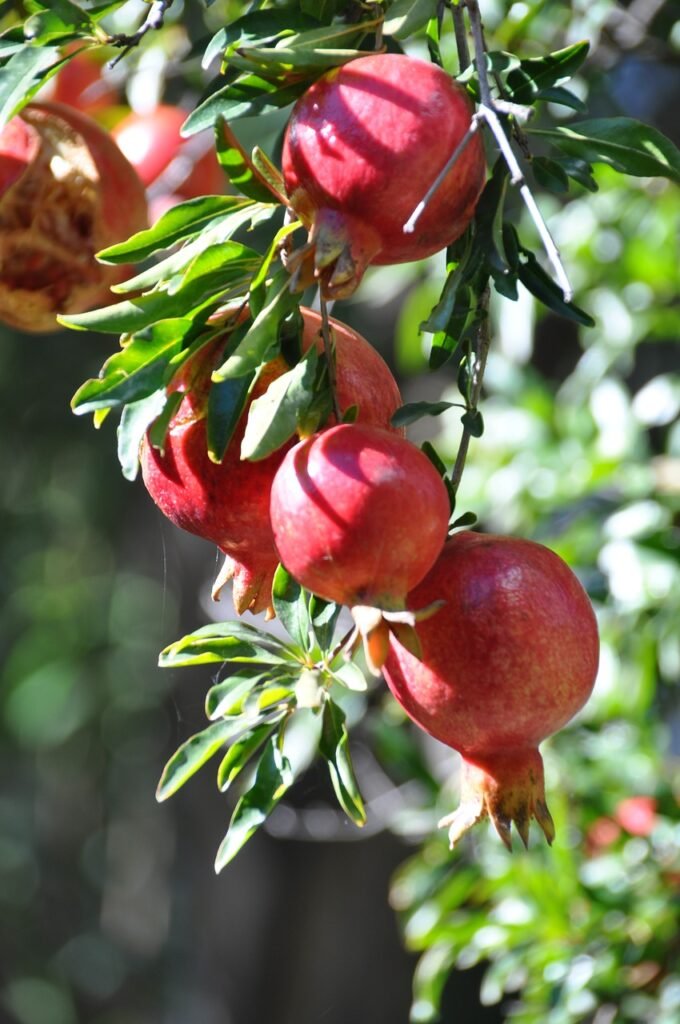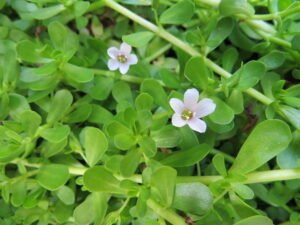How To Plant, Grow, And Care for Pomegranate Tree

Pomegranate Tree
The pomegranate tree, scientifically known as Punica granatum, is a deciduous shrub or small tree that is native to the Mediterranean region. With its vibrant flowers, delicious fruit, and numerous health benefits, the pomegranate tree is a must-have for any gardening enthusiast. In this article, we will explore the beauty and benefits of the pomegranate tree, and provide you with tips on how to grow and care for this amazing plant.

The pomegranate tree is known for its attractive and showy flowers, which range in color from vibrant reds and oranges to soft pinks and whites. These flowers draw pollinators like bees and butterflies to your yard in addition to adding a splash of color.
But the beauty of the pomegranate tree doesn’t stop at its flowers. Once the flowers have been pollinated, they give way to the iconic pomegranate fruit. These fruits are round and leathery with a bright red or yellow exterior. When you cut open a pomegranate, you will find juicy, ruby-red seeds called arils, which are the edible part of the fruit. The combination of the deep red arils and the yellowish-white membrane creates a visually stunning display.
Facts About Pomegranate Tree
Pomegranate trees, scientifically known as Punica granatum, are native to the Middle East and parts of South Asia. They have a long history of cultivation dating back thousands of years, with evidence of their presence in ancient Egyptian tombs and Greek mythology.
Today, pomegranate trees are grown in many parts of the world, including the Mediterranean region, California, and the Indian subcontinent. They thrive in warm climates with well-drained soil and plenty of sunlight.
Pomegranates have long held symbolic and cultural significance in various societies. In ancient Greek mythology, the pomegranate was associated with fertility and the underworld. In Jewish tradition, it is a symbol of righteousness and abundance.
In many cultures, pomegranates are used in religious ceremonies and celebrations. They are often seen as a symbol of prosperity, good luck, and fertility. The vibrant red color of the fruit is also associated with love and passion.
Aside from their delicious taste, pomegranates also offer numerous health benefits. Studies have shown that they have anti-inflammatory and antioxidant properties, which can help protect against chronic diseases such as heart disease and cancer.
Pomegranate juice has also been found to have potential benefits for cardiovascular health, including reducing blood pressure and improving cholesterol levels. Additionally, it may have anti-aging effects on the skin and promote overall well-being.
FAQ About Pomegranate Tree
How tall do pomegranate trees grow?
Pomegranate trees can grow anywhere from 12 to 30 feet tall, depending on the variety and growing conditions. However, with regular pruning and maintenance, you can keep them at a more manageable height.
When do pomegranate trees bear fruit?
After planting, pomegranate trees usually begin to yield fruit in two to three years. Depending on the variety and growing environment, the precise timing may change. In general, you can expect the fruit to mature and be ready for harvest in late summer to early fall.
Do pomegranate trees require pruning?
Yes, pruning is important for pomegranate trees to maintain their shape, promote air circulation, and encourage fruit production. When your tree is dormant, which is usually in late winter or early spring, you should prune it. Remove any dead, damaged, or crossing branches. You can also selectively prune to control the tree’s height and shape. Pruning too much should be avoided as it may lower fruit yield.
Can I grow a pomegranate tree in a container?
Yes, pomegranate trees can be grown in containers, making them suitable for small gardens, patios, or balconies. Choose a dwarf or compact variety that is better suited for container growing. Use a well-draining potting mix and a container that is at least 18 inches in diameter. Place the container in a sunny location and water regularly, allowing excess water to drain out of the pot. To keep the tree in its proper size and shape, prune it as needed.
Right Location For Pomegranate Tree
Before you start planting your pomegranate tree, it’s important to choose the right location. Pomegranate trees thrive in areas with full sun exposure, so make sure to select a spot in your garden that receives at least 6 to 8 hours of direct sunlight each day.
Pomegranate trees require well-draining soil to prevent waterlogging and root rot. They prefer a soil that is loamy and sandy, allowing excess water to drain away quickly. Heavy clay soils should be avoided, as they tend to retain water and can suffocate the roots of the tree. You can add organic matter, such compost or well-rotted manure, to your garden’s clay soil to help with drainage.
The pH level of the soil is another important factor to consider when planting a pomegranate tree. Pomegranates prefer slightly acidic to neutral soil, with a pH level ranging from 5.5 to 7.0. Most garden centers sell soil testing kits that you can use to determine the pH level of your soil. You can add lime to your soil to improve the pH if it’s too acidic. If it is too alkaline, you can lower the pH level by adding sulfur or peat moss.
It’s also worth considering the climate in your region. Pomegranate trees are adaptable and can tolerate a wide range of climates, but they prefer areas with hot summers and cool winters. If you live in a region with extremely cold winters, you may need to take extra precautions to protect your pomegranate tree from frost damage.
How To Plant Pomegranate Tree
Once you have chosen the right location, it’s time to plant your pomegranate tree.
- Prepare the soil: Remove any grass or weeds from the area before planting to help prepare the soil. To increase fertility and drainage, loosen the soil and incorporate some organic matter, such as compost.
- Dig a hole: Dig a hole that is slightly larger and deeper than the root ball of your pomegranate tree.
- Place the tree: Gently place the pomegranate tree into the hole, making sure the top of the root ball is level with the ground.
- Backfill the hole: Gently compact the earth around the tree’s base after adding soil to the hole. To promote root growth, the soil should not be compacted excessively.
- Water thoroughly: After planting, water the tree thoroughly to help settle the soil and remove any air pockets.
It’s important to note that pomegranate trees are self-pollinating, which means you only need one tree to produce fruits. However, if you have enough space, planting multiple trees can increase cross-pollination and potentially improve fruit production.
How To Care For Pomegranate Tree
Watering
Watering pomegranate plants on a regular basis is necessary, particularly during the growing season. As a general guideline, water the tree deeply once a week. However, the frequency could change based on variables including age of the tree, kind of soil, and climate. Younger trees may require more frequent watering compared to established ones.
When watering, it is important to ensure that the water reaches the tree’s root system. Deep watering encourages the roots to grow deeper into the soil, making the tree more resilient and less dependent on frequent watering. Use a soaker hose or drip irrigation system to deliver water directly to the root zone.
Watering your pomegranate tree in the early morning is ideal. This lowers the chance of fungal illnesses by allowing the leaves to dry off during the day. Watering in the evening or at night can keep the leaves damp for an extended period, creating a favorable environment for diseases to thrive.
Regularly check the moisture level of the soil around your pomegranate tree. Insert your finger into the ground about one inch deep. If it feels dry, it’s time to water. If it feels moist, you can hold off watering for a little longer. Avoid overwatering, as it can lead to root rot and other issues.
Fertilizing
The timing of fertilization is crucial to ensure optimal results. It’s best to fertilize your pomegranate tree in early spring, just before new growth begins. This allows the tree to absorb the nutrients and utilize them effectively during the active growing season.
It’s important to note that young pomegranate trees require different fertilization schedules compared to mature ones. For young trees, it’s recommended to fertilize every four to six weeks during the growing season. Mature trees, on the other hand, only need fertilization once or twice a year.
When it comes to choosing the right fertilizer for your pomegranate tree, it’s essential to consider its specific nutrient requirements. Look for a balanced fertilizer with a ratio of nitrogen (N), phosphorus (P), and potassium (K).
A general rule of thumb is to use a fertilizer with an NPK ratio of 10-10-10 or 14-14-14. However, it’s always a good idea to conduct a soil test to determine the exact nutrient deficiencies in your soil. This will help you choose a fertilizer that addresses those specific needs.
Organic fertilizers, such as compost or well-rotted manure, are also excellent options for pomegranate trees. They provide a slow release of nutrients and improve the overall soil structure and fertility.
Now that you know the importance of fertilizing and have chosen the right fertilizer, it’s time to learn how to properly apply it to your pomegranate tree.
Start by watering the tree thoroughly a day or two before applying the fertilizer. This helps ensure that the nutrients will penetrate the root zone effectively.
Next, sprinkle the fertilizer evenly around the base of the tree, avoiding direct contact with the trunk. Be careful not to apply too close to the trunk, as it can cause root burn or damage.
After applying the fertilizer, gently work it into the top layer of soil using a rake or a hand cultivator. This will help the nutrients reach the root system more efficiently.
Finally, water the tree again to help the fertilizer dissolve and reach the roots. This step is crucial for proper nutrient absorption.
Pruning
Pruning is an important part of pomegranate tree care, as it helps maintain the tree’s shape, promote air circulation, and stimulate fruit production.
The best time to prune your pomegranate tree is during the dormant season, which typically occurs in late winter or early spring. Pruning during this time allows the tree to recover quickly and minimizes the risk of disease or pest infestation. It is important to avoid pruning during the active growing season, as this can disrupt the tree’s growth and fruiting process.
When pruning your pomegranate tree, it’s important to follow these techniques to ensure proper growth and development:
- Remove dead or diseased branches: Start by identifying any dead or diseased branches. These branches can hinder the tree’s overall health and productivity. Using your pruning shears or loppers, cut these branches back to the nearest healthy growth point.
- Thin out crowded branches: Look for branches that are crossing or rubbing against each other. These branches can create wounds and provide an entry point for pests and diseases. Carefully remove the weaker or less desirable branches to improve air circulation and sunlight penetration.
- Shape the tree: Pomegranate trees can be pruned to a desired shape, such as a vase or open-center form. This helps maintain a balanced structure and allows sunlight to reach all parts of the tree. Remove any branches that are growing inward or crossing the center of the tree.
- Prune for size control: If your pomegranate tree is getting too large for its space, you can prune it to control its size. Cut back the branches to the desired height or width, keeping in mind that severe pruning may reduce fruit production for a year or two.
Training
Pomegranate trees can be trained to a central leader or an open vase shape. Choose the desired shape and prune accordingly. Remove any competing central leaders or crossing branches to maintain a strong and balanced framework.
Regular pruning will help keep your pomegranate tree healthy and productive. However, be cautious not to prune excessively, as this can reduce fruit production.
Winter Care
Pomegranate trees are generally hardy, but they can still be susceptible to frost damage during the winter. When temperatures drop below freezing, it is important to take steps to protect your tree.
One method of frost protection is to cover the tree with a frost cloth or blanket. This helps to trap heat and create a warmer microclimate around the tree. Make sure to secure the covering to prevent it from blowing away in strong winds.
If your pomegranate tree is in a container, you can move it to a sheltered location such as a garage or shed during periods of extreme cold. This provides additional protection from frost and harsh winter conditions.
Pest and Disease Control
In general, pomegranate trees are resistant to illnesses and pests. However, they can still be affected by certain issues. Here are some common pests and diseases that may affect your pomegranate tree and how to control them:
Aphids: These tiny insects gather together on the undersides of leaves, where they drink the tree’s sap.
Whiteflies: Whiteflies are small, winged insects that feed on the undersides of leaves. To manage whiteflies, use insecticidal soap or yellow sticky traps.
Fungal diseases: Pomegranate trees can be susceptible to fungal diseases, such as powdery mildew and root rot. To prevent fungal infections, avoid overwatering and provide good air circulation around the tree. If necessary, use fungicides labeled for pomegranate trees.
Leaf spot: Leaf spot is a common fungal disease that causes dark spots on the leaves. Remove and destroy infected leaves and use fungicides if necessary.
Regularly inspect your pomegranate tree for any signs of pests or diseases, and take appropriate action as soon as possible to prevent further damage.
How To Harvest Pomegranates
It’s time to savor the results of your effort after all your hard work! Pomegranates are typically ready for harvest in late summer or early fall, depending on the variety and climate. Here’s how to know when to harvest your pomegranates:
Color: Pomegranates should have a deep, rich color when they are ready to harvest. The exact color will depend on the variety, but they should no longer be green or yellow.
Texture: To determine whether the fruit is ripe, gently squeeze it. Ripe pomegranates should feel firm but slightly soft. Avoid harvesting fruits that are too hard or too soft.
Sound: If you tap a ripe pomegranate, it should make a metallic sound. Immature fruits will sound dull.
To harvest the pomegranates, simply cut the fruit from the tree using sharp pruning shears. Leave a short stem attached to the fruit. Pomegranates can be stored in a cool, dry place for several weeks, or you can refrigerate them to extend their shelf life.
Planting, growing, and caring for a pomegranate tree can be a rewarding experience. With the right location, proper watering and fertilizing, regular pruning, and pest control, you can enjoy a bountiful harvest of delicious pomegranates. Remember to choose a sunny spot in your garden, provide adequate water and nutrients, and protect your tree from pests and diseases. Follow the guidelines in this guide, and soon you’ll be enjoying the beauty and taste of your very own pomegranate tree.





